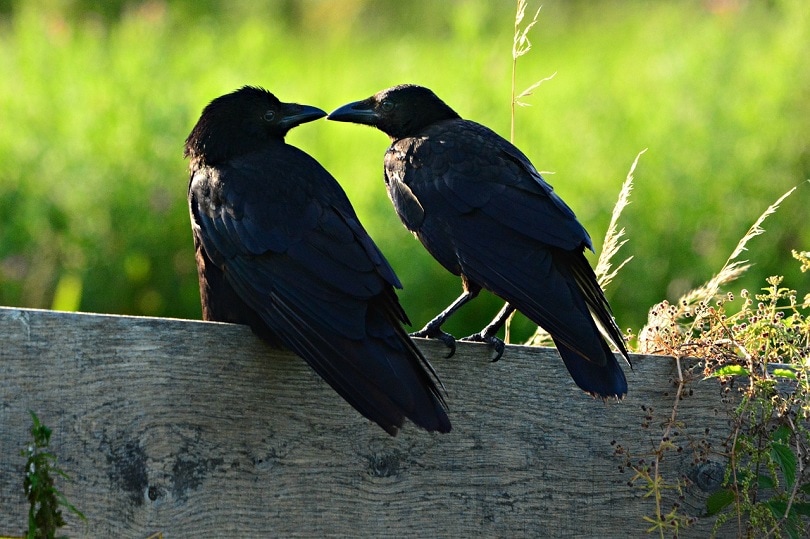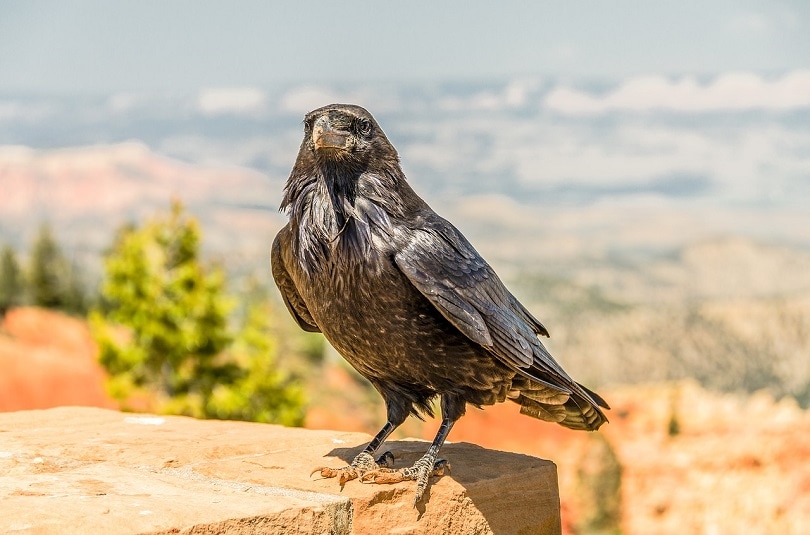13 Proven Ways to Attract Crows to Your Yard & Feeders (2025 Guide)
Last Updated on

Crows are a member of the corvid family. They are intelligent, interesting, and quirky, and they can make an appealing addition to your garden. They do have a loud and non-melodious call, and they can scare smaller birds away from your garden, but they are intriguing and interesting in their own right. Crows are omnivores and can be scared of loud noises and sudden movements. Although they’re bigger than the average garden bird, they will still shy away from cats and dogs. Here are 13 ways that you can attract crows to your garden and get them to eat from your feeders.
1. Offer Roosting Sites

Crows enjoy communal roosting, which means that they need plenty of space for their roosting sites. Groups of trees are ideal because they have the vantage point of height combined with the convenience of horizontal branches upon which to sit. If you don’t have trees already, it is impractical to plant them and wait for them to grow just so you can offer roost sites for visiting crows.
2. Set Up Roosting Poles

If you don’t have trees in or near your garden, you may still be able to offer appealing roost sites. You can set up roosting poles. These are tall vertical poles with horizontal perches at the top. Modified fence posts can work, but you may need to find a way to prevent cats from climbing the fence to reach the crows.
In the same way that you like to watch crows, the crows enjoy watching back, and this kind of perch allows them to watch you, other birds, and potential prey.
3. Add a Bird Bath

All birds need a birdbath. They use water for bathing, drinking, and feather maintenance. They also use it to cool off during the hot summer months. Birdbaths offer your crows somewhere to perch, and while baths can take many forms, old-fashioned and tough concrete baths tend to do well when used for crows because they are steady and sturdy.
Birdbaths also allow you to witness unusual corvid behavior. For example, crows might moisten food to soften it up before taking it back to the nest.
4. Take Down the Windchimes

Despite being big birds and quite vocal, crows dislike sudden noises that startle them. Remove windchimes, bells, and other items that make sudden noises. Some noise can’t be helped when it’s windy, but crows will remember those spots that are too noisy for them to settle, and they will be less inclined to visit in the future.
5. One Crow Begets Another

Crows are sociable birds and like to spend time with other crows. Once you do attract your first crow, the number of birds that visit your garden is likely to keep growing and growing, but you need to provide a good reason for that first crow to call.
You can buy crow decoys, which look like crows and can be placed in birdbaths, on feeders, and in other locations around your garden. Passing crows will see the decoy and investigate. If you provide a reason for them to stay and remove reasons for them to leave, the inquisitive crows will likely become regular visitors.
6. Caws to Call

Similarly, you can use a crow caller to give the impression that your little feeding spot already has visiting crows. Some callers are manual and require you to blow into them, while others are electronic or digital and will work automatically even when you’re not there.
7. Go Nuts

Foraging crows will be on the lookout for appealing food as they pass overhead, so you need to make sure that you provide forage that looks good and will appeal to the crows that you want to attract.
Peanuts are large enough to be visible and are popular with this species of bird. Lay them out in a location that is easy to see from above, add more to your feeder, and then sit back and wait.
8. Make It a Habit

Crows, like most birds, will visit the places they know and where they will have an opportunity to get food and water. If you put out food and forage for them, they are likely to come back again to check out the area and see whether there is more food.
Get into the habit of putting food out in similar spots and at the same time, and you should find that your visiting crows will start to call back every day.
9. Ensure That Your Feeder Is Visible

Feeders tend to be made from natural materials and hung from trees or in other areas of the garden, but you want to ensure that the feeder is highly visible. Consider putting it in the middle of the lawn, and make sure that it includes food that will attract passing crows. If you have a feeder in a bush, surrounded by foliage, it will be difficult to spot even for the keen eyes of a crow.
10. One Man’s Trash

Crows are omnivores. They will eat anything available to them. This can include nuts and seeds and other food in your feeder, as well as insects. In particular, they love the grubs that are often found in compost.
Place a compost bin out, and fill it with rich soil and vegetation. The crows will come to eat the worms and small flies, and they will return for more.
11. While the Cat’s Away

Crows are alert and intelligent. They also have good memories. If you have a cat and they startle the crows in your garden, the crows will remember this. They may come back if the allure of food is great enough, but the more often that they are startled by your or your neighbor’s cats, the less likely they will be to return each time. Try to prevent cats from coming around if you want more crows visiting.
Also, this might explain why crows will not visit your garden if you have recently moved. The old owners may have had cats or encouraged cats into their garden. It will take a while for the crows to forget that and start to trust you.
12. Shiny, Shiny

This one may work or it may actually put crows off. Considering that they are easily startled, shiny objects that suddenly catch the light could scare your crows away. That said, there are many anecdotal stories of crows enjoying shiny objects. It may be best to wait until you have developed some kind of relationship with your crow visitors before leaving out shiny objects for them.
13. Give Them Space

Crows are wild birds. Over time, you may be able to attract them to your garden and encourage them to eat from your feeders. They may even be quite happy to share the garden space with you once they have developed a high level of trust, but they are still wild birds, and you need to give them space. If a relationship is to develop, it needs to be on the crows’ terms, so let them come to you.

Ways to Attract Crows to Your Garden
Crows are intelligent, occasionally friendly, and always intriguing. They can make great additions to your garden space, and over time, you can forge a friendship with these birds. However, you will need to provide a good roosting spot, decent food, and a place that is free from dangers and distractions.
These tips should help you attract crows, but it does take time, and it may never happen, no matter how hard you try.
Check out some of our other top-trending posts:
- 7 Proven Ways to Attract Blue Jays to Your Yard
- How to Use a Spotting Scope for Birding (4 Helpful Tips)
- 8 Proven Ways to Keep Squirrels Out of Bird Feeders
- Do Crows Eat Squirrels? Do They Attack Squirrels?
Featured Image Credit: MabelAmber, Pixabay
Table of Contents
- 1. Offer Roosting Sites
- 2. Set Up Roosting Poles
- 3. Add a Bird Bath
- 4. Take Down the Windchimes
- 5. One Crow Begets Another
- 6. Caws to Call
- 7. Go Nuts
- 8. Make It a Habit
- 9. Ensure That Your Feeder Is Visible
- 10. One Man’s Trash
- 11. While the Cat’s Away
- 12. Shiny, Shiny
- 13. Give Them Space
- Ways to Attract Crows to Your Garden
About the Author Robert Sparks
Robert’s obsession with all things optical started early in life, when his optician father would bring home prototypes for Robert to play with. Nowadays, Robert is dedicated to helping others find the right optics for their needs. His hobbies include astronomy, astrophysics, and model building. Originally from Newark, NJ, he resides in Santa Fe, New Mexico, where the nighttime skies are filled with glittering stars.
Related Articles:
How to Clean a Refractor Telescope: Step-by-Step Guide
How to Clean a Telescope Eyepiece: Step-by-Step Guide
How to Clean a Rifle Scope: 8 Expert Tips
Monocular vs Telescope: Differences Explained (With Pictures)
What Is a Monocular Used For? 8 Common Functions
How to Clean a Telescope Mirror: 8 Expert Tips
Brightfield vs Phase Contrast Microscopy: The Differences Explained
SkyCamHD Drone Review: Pros, Cons, FAQ, & Verdict
